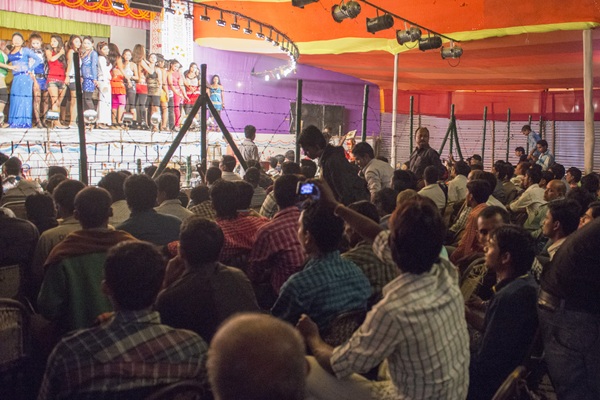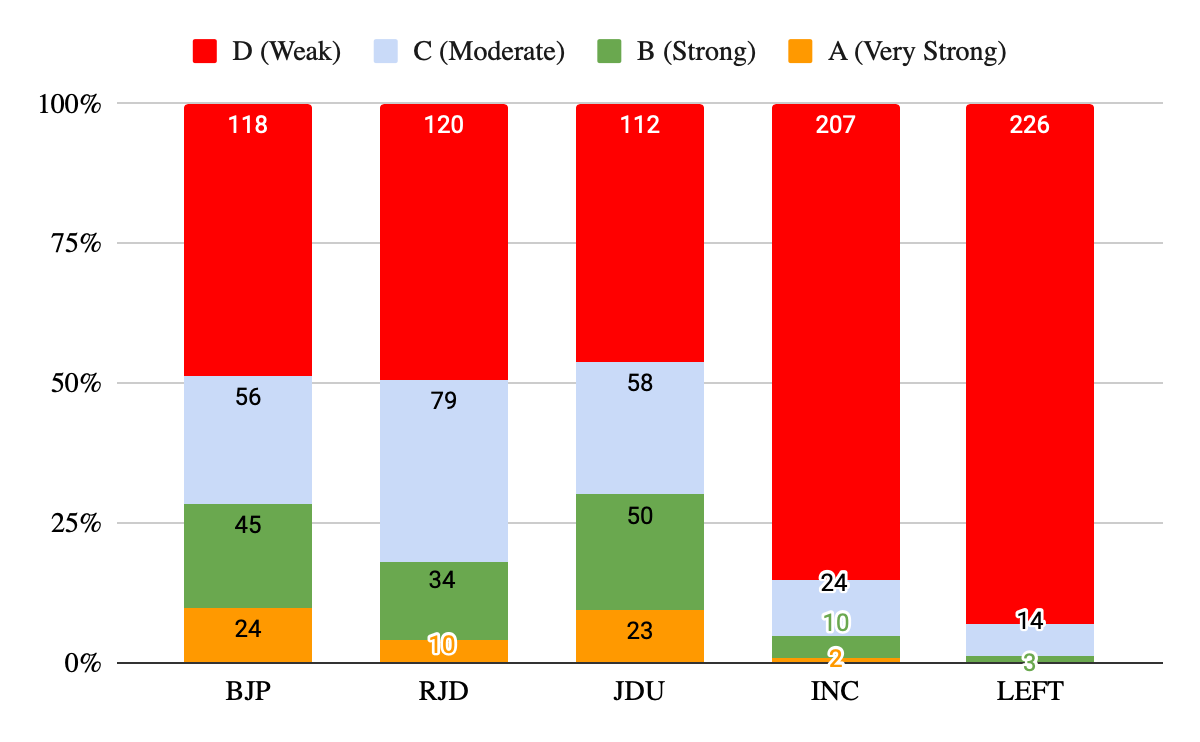.png)
The ABC and D of Bihar Elections
Bihar heads into the 2025 polls with 74.2 million voters and a three-cornered contest between NDA, Mahagathbandhan, and Jan Suraj. At the heart of the battle lies the ABCD seat classification system; a metric that reveals where each alliance truly stands.

Amitabh Tiwari, formerly a corporate and investment banker, now follows his passion for politics and elections, startups and education. He is Founding Partner at VoteVibe.
October 4, 2025 at 6:00 AM IST
The Election Commission of India has released the final electoral roll with 74.2 million voters after a three month SIR exercise. The dates are expected anytime soon with Bihar witnessing an enthralling contest between NDA, MGB and Jan Suraj emerging as a third force.
Understanding the Seat Strength Matrix
Who will win Bihar?
The cues to the outcome lies in a simple yet revealing metric: the ABCD seat classification system. This analytical framework categorises constituencies based on their electoral history since the 2008 delimitation, offering crucial insights into which alliance holds the structural advantage.
The classification is straightforward yet powerful:
- A (Very Strong): Seats won by a party in all three elections (2010, 2015, 2020) since delimitation in 2008 is classified as “A” for that party
- B (Strong): Seats won by a party in two out of last three elections is classified as “B”
- C (Moderate): Seats won by a party in one out of last three elections is classified as “C”
- D (Weak): If a party has not won a sweat ever in the last three elections, including seats not contested, is classified as “D”
JDU/BJP have High “A/B” Category Seats
JDU and BJP have 23 and 24 “A” Category seats, while RJD has just 10, Congress two such seats. JDU and BJP have 50 and 45 “B” Category seats, while RJD has 34, Congress 10 and Left Parties 3 such seats. JDU and BJP have 58 and 56 “C” Category seats, while RJD has 79, Congress 58 and Left Parties (CPI, CPIM, CPIML) 14 such seats.
ABCD Classification (Strength Scanner of Parties)
In effect, NDA has 47 very strong seats while MGB has 12 such seats. There are further 17 very strong seats for NDA which JDU or BJP has won twice and the other partner once making it 3/3 wins. This gives an edge to the NDA going into the 2025 state elections.
The Regional Strongholds
The electoral geography of Bihar reveals stark patterns of dominance. The JD(U) and BJP have established formidable fortresses in North Bihar. JDU has 40 out of its 73 very strong/strong seats in North Bihar while BJP has 49 out of 69 seats in the region. 62% of JDU and BJP stronghold seats are in North Bihar.
This northern dominance gives the NDA a critical geographical advantage as the region houses 58% of total seats.
In contrast, the MGB party's power base lies in South Bihar. RJD has 24 of its 44 very strong/strong seats in South Bihar, Congress 10 of its 12 such seats and Left Parties 1 of 3 such seats. 59% of RJD, INC and Left Parties stronghold seats are in South Bihar giving it an edge in this region.
This regional bifurcation suggests that the battle for Bihar will be fought on two distinct fronts, with each alliance defending its traditional territory while attempting incursions into opposition strongholds.
|
PARTY |
NORTH BIHAR |
SOUTH BIHAR |
||
|
A |
B |
A |
B |
|
|
BJP |
19 |
30 |
5 |
15 |
|
JDU |
14 |
26 |
9 |
24 |
|
RJD |
6 |
14 |
4 |
20 |
|
INC |
2 |
0 |
4 |
6 |
|
LEFT |
0 |
2 |
0 |
1 |
Note: North Bihar includes Saran, Tirhut, Darbhanga, Kosi, and Purnia. South Bihar includes Bhojpur, Patna, Magadh, Muger and Bhagalpur.
The Caste Arithmetic Behind the Numbers
The strength scanner reveals fascinating caste-based patterns that undergird Bihar's electoral mathematics. Among RJD's ten very strong seats, six are in Yadav-dominated constituencies where the community comprises more than 20% of the population.
Even more tellingly, five of these seats have a Muslim-Yadav (MY) population exceeding 35%, highlighting the party's dependence on this core vote bank.
The JD(U)'s electoral architecture tells a different story. In nine of its 23 very strong seats, the combined Kurmi and Koeri population exceeds 15%, significantly higher than their 7% share in the state's actual population. 14 of the 23 seats have >30% EBC (Extremely Backward Classes) and NYOBC (Non Yadav OBC) population.
Of the BJP’s 24 very strong seats, 13 have more than 30% EBC and NYOBC population, 8 have upper caste population of >15%, state average around 11%. This highlights JDU and BJP successful consolidation of Hindu Non-Yadav OBCs and Hindu EBCs which combined account for 37% of the population.
The 2010 Sweep and Its Lingering Impact
The NDA's structural advantage in strong and very strong seats is not accidental but rather a direct consequence of its comprehensive victory in 2010, when the alliance secured more than 200 seats.
However, this advantage masks significant internal shifts within the NDA. The JD(U) has experienced a dramatic decline, plummeting from 115 seats in 2010 to just 43 in 2020; a loss of 72 seats that represents one of the most precipitous falls in Bihar's recent political history.
The Mahagathbandhan's Structural Weakness
The Mahagathbandhan's challenge extends beyond RJD's individual performance. The alliance suffers from a critical weakness: its constituent parties INC and Left collectively possess fewer strong and very strong seats compared to the NDA.
This fragmentation means that even if RJD performs well, compensating for another's losses becomes mathematically difficult. The RJD, despite being the single largest party in the opposition, faces a unique handicap. The 2010 debacle where it won just 22 seats continues to haunt the RJD's statistical profile more than a decade later.
The Path to Victory
For the RJD and Mahagathbandhan to prevail, they must execute a two-pronged strategy. First, they need to dramatically improve their win rate in moderate (C category) seats. Second, and more challenging, they must breach the NDA's fortress in North by winning in constituencies currently classified as strong or very strong.
This is an uphill task, but recent electoral history offers a glimmer of hope. In the 2024 Lok Sabha elections, the BJP managed to win only 70% of its A and B category seats; a significant shortfall that suggests even strong seats are not immune to electoral swings under the right conditions.
The 2025 Verdict
The party that can best navigate the moderate seats—those won once in the last three elections—while defending its strongholds will likely determine Bihar's political direction. In a state where margins are often razor-thin, 78 seats won/lost with <=5% margin and alliances can shift overnight, the strength scanner provides not a prophecy but a probability matrix.
And in Bihar's volatile politics, probabilities can be defied by the right combination of leadership, messaging, and ground-level mobilisation.



